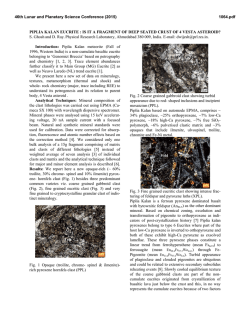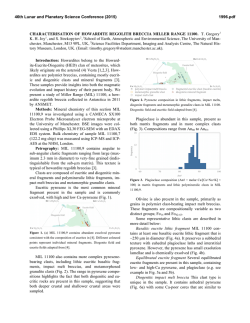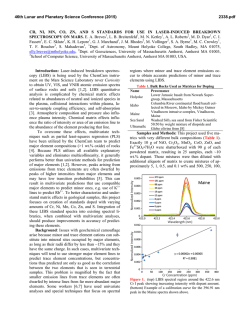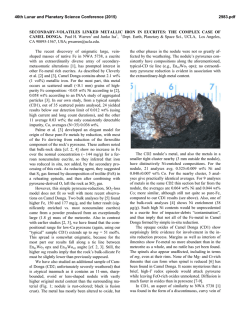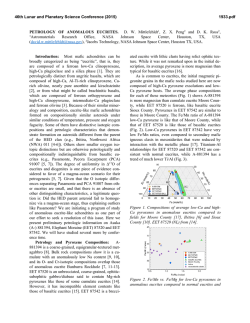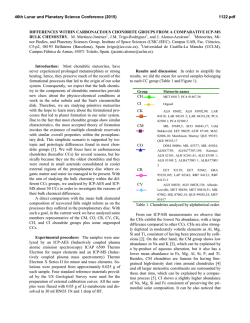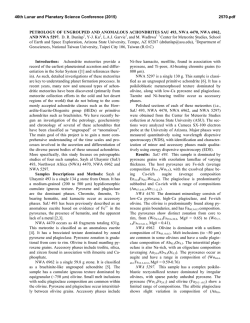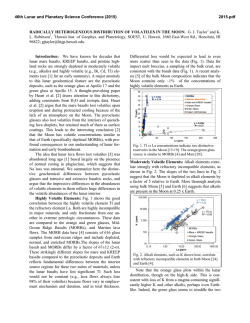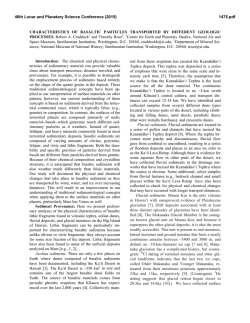
BASALTIC EUCRITES SIMILAR TO TERRESTRIAL MORBs: A
46th Lunar and Planetary Science Conference (2015) 1356.pdf BASALTIC EUCRITES SIMILAR TO TERRESTRIAL MORBs: A GEOCHEMICAL APPROACH. A.D. Shukla ([email protected]), D. Ray ([email protected]) and, N. Bhanadri. Physical Research Laboratory, Ahmedabad 380 009, India. (1.04 against 1.01). No Eu anomaly (Eu/Eu*~ 1.07) is noted in either of the two. 1000 Chondrite Normalised 100 10 N-MORB 1 E-MORB OIB Juvinas 0.1 Piplia 0.01 Rb Ba Th U Nb Ta La Ce Pb Pr Nd Sr Zr Hf Sm Eu Gd Tb Dy Ho Y Er Yb Lu Fig. 1. Chondrite normalized trace element spidergram of Piplia Kalan and Juvinas eucrite. N- MORB, EMORB and Ocean Island Basalt (OIB) (after [9]) data are also incorporated for comparison (chondrite data after [10]). In bivariant plot of Ta/La (incompatible element ratio) against Ta (least compatible element amongst the pair, [11]), there is a steep increase of Ta/La as Ta increases (r2=0.87) (Fig. 2). Fractional crystallization and partial melting produces different slopes in this process identification plot, e.g. slope is steeper for partial melting vis-à-vis fractional crystallization. 0.09 R2 = 0.87 0.08 Ta/La Introduction: Eucrites are the most differentiated member of HED clan or, basaltic achondrite and describe a magmatic history of the early solar system [1]. In a recent study, visible and near- IR spectroscopy data of Asteroid 4-Vesta show mineralogical similarities with those of HED meteorites and link the latter with 4-Vesta crust [2]. Mid-Ocean Ridge Basalts (MORBs) are the most voluminous magmatic province of Earth (~60% of total magma flux). Based on trace element abundance pattern, MORBs are classified into N- MORB (normal), E-MORB (enriched) and T-MORB (transitional) types. Here we have made an attempt to assign the status of basaltic eucrite in terms of MORBs referred to as terrestrial analogue. Earlier workers [3,4] have reported a close resemblence of eucrite geochemistry with mare basalt of the Moon. Recent geochemical overview has also indicated a close link between lowTi mare basalts and E-MORB in terms of trace elements chemistry [5]. As eucrite petrogenesis is enigmatic, our focus in this study involves identification of igneous processes through the behaviour of trace element abundances of a basaltic (noncumulate) eucrite, Piplia Kalan (Fall, India, 1996) and its comparison with that of MORBs since eucrites are similar to terrestrial basalts in terms of mineralogy and texture (rapidly cooled in the form of lava or shallow intrusion). Analytical Techniques: Trace element compositions of whole-rock sample were carried out using Inductively Coupled Plasma Mass Spectrometer (ICPMS, Thermo XSeries II) at Physical Research Laboratory, Ahmedabad, India. BHVO 2 was used for calibration standard during ICP-MS. Accuracy and precision is better than ±5% for most of the elements except for Pb, it is 6%. Results: Piplia Kalan has been classified as ‘Genomict Breccia’ based on the nature of individual clasts which are of similar chemistry but of different petrographic textures [6,7]. Chondrite normalized bulk trace element data (Fig. 1) suggests Juvinas [8] is the closest neighbor of Pipila Kalan, except the latter is enriched in Rb, Ba, Th, U (2.5 to 16 times) and marginally depleted in Zr anf Hf (6 to7 times). Interestingly, Piplia Kalan trace element data fall close to E-MORB composition and these are reflected in several ratios like Ba/LuN (Pipilia Kalan:1.80, EMORB:1.74), La/SmN (1.12 against 1.51) and Gd/YbN 0.07 0.06 Piplia Kalan (lit) Juvinas Present data 0.05 0.04 120 140 160 180 200 220 240 Ta (ppb) Fig. 2. Plot of Piplia Kalan in Ta/La versus Ta (process identification plot, after [11]) We have tested several other trace element discrimination plots to confirm the E-MORB linkages. Piplia Kalan falls on the MORB-OIB array, towards the enriched mantle source in Th/Yb versus Nb/Yb plot (after [12]) while in Nb/Sm versus La/Sm plot Piplia Kalan is more akin to T-MORB (Fig. 3). La/SmN ratio of Piplia Kalan (1.12) falls in the range of Mid- 46th Lunar and Planetary Science Conference (2015) Atlantic Ridge T- MORB (0.98, [13]) or Equatorial Western Pacific T-MORB (0.95, [14]). Low Zr/Nb (4.68) and moderate Nb/Y (0.20) ratios of Piplia Kalan are also similar to E-MORB (8.8, 0.38) . 10 MORB T-MORB (MAR) T-MORB (EPR) N-MORB E-MORB OIB Th/Yb 1 Pipilia Kalan Juvinas 0.1 0.01 0.1 12 8 MORB T-MORB (MAR) T-MORB (EPR) N-MORB E-MORB OIB 6 Pipilia Kalan Juvinas 10 Nb/Sm 1 Nb/Yb 10 100 4 2 0 0 1 2 3 La/Sm 4 5 6 Fig. 3 Trace element bivariant plots (Th/Yb versus Nb/Yb and Nb/Sm versus La/Sm) for global MORB and non cumulate Eucrite (Piplia Kalan and Juvinas) In Nb/U versus U/Th plot, Piplia Kalan falls within the MORB-OIB array while Juvinas and Mid-Atlantic Ridge T-MORB are more akin to OIB (Fig. 4). Nb/U 100 MORB T-MORB (MAR) T-MORB (EPR) N-MORB E-MORB OIB 10 PK Juvinas 1 0.1 U/Th 1 Fig. 4. Plot of Global MORB and Piplia Kalan eucrite in Nb/U versus U/Th binary diagram after [15]. 1356.pdf Discussion: Our present geochemical comparison of Piplia Kalan eucrite with MORB suggests the following: (i) Piplia Kalan magma was evolved through partial melting-dominated process rather than fractional crystallization. (ii) Based on trace element abundances, Piplia Kalan is more akin to E-MORB, more specifically between TMORB and E-MORB. (iii) Incompatible trace element ratios of Piplia Kalan closely resemble with T-MORB of Mid-Atlantic Ridge and Equatorial Pacific and fall well within the terrestrial MORB-OIB array. (iv) High La/SmN (>1) and low Zr/Nb (<10) ratios along with overall resemblance to E-MORB further suggest that the source mantle composition of Piplia Kalan was relatively fertile as compared to terrestrial depleted N-MORB. Barring minor depletion of high field strength elements and higher Nb/Yb ratio (~2.5) trace element ratios of Piplia Kalan in general is consistent with a probable mixing of E-MORB and NMORB-like mantle source. It is inferred from the limited trace element data of Piplia Kalan that E-MORB could be considered a potential terrestrial analogue for Main Group Eucrite. MORB-like chemical composition may be comparable with planery crust of other basaltic terrestrial planets and therefore call for future investigation. Acknowledgement: We are thankful to Dr. S. Ghosh for helpful comments. References: [1] Mittlefehldt D.W. et al. (1998) Rev. Mineral. 36, 4.1-4.195. [2] De Sanctis M.C. et al. (2012) Science 336, 697-700. [3] Duke M.B. and Silver, L.T. (1967) Geochim. Cosmochim. Acta 31, 1637-1665. [4] Ruzicka A. et al. (2001) Geochim. Cosmochim. Acta 65, 979-997. [5] Ray D. and Misra S. (2012) EPSC abstract 7, 2012-73-1. [6] Shukla A.D. et al. (1997) Met. Planet. Sci. 32, 611-615. [7] Buchanan P.C. et al. (2000) Met. Planet. Sci. 35, 609-615. [8] Barrat J.A. et al. (2007) Geochim. Cosmochim. Acta 71, 4108-4124. [9] Sun S.-S. and McDonough W.F. (1989) Geol. Soc. Spec. London, 42, 313-345. [10] McDonough W.F. and Sun S.S. (1995) Chem. Geol. 120, 223-253. [11] White W.M. (2008) Geochemistry In: Encyclopedia of Earth Sciences, Macmillan, New York (online version). [12] Pearce J.A. and Peate D.W. (1995) Annu. Rev. Earth Planet. Sci. 23, 251-285. [13] White W.M. and Klein E.M. (2014) Treatise on Geochemistry, 2nd ed, 457-496. [14] Park S.-H. et al. (2006) Earth Planet. Sci. Lett. 248, 700-714. [15] Hofmann A.W. (2003). Treatise on Geochemistry 2, 61-101.
© Copyright 2025
